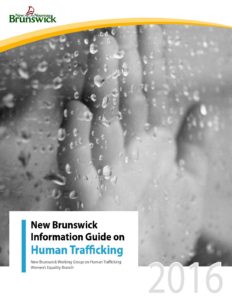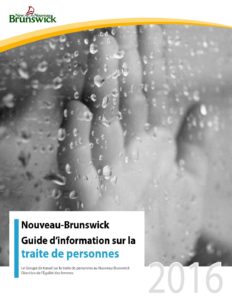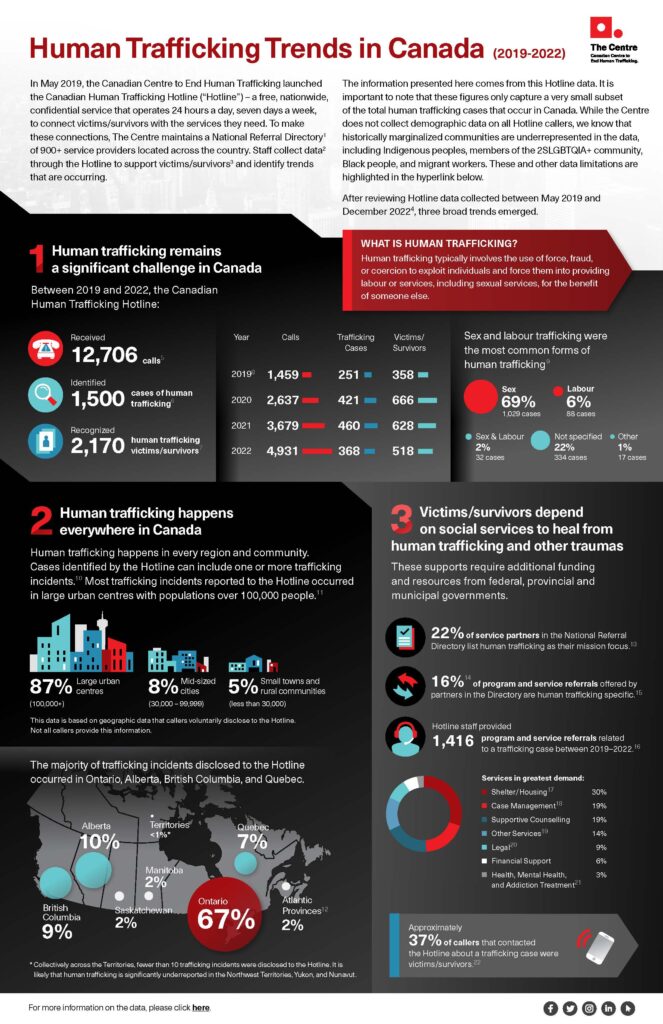
Human Trafficking Trends in Canada (2019-2022)
Human trafficking remains a significant challenge in Canada, new data reveals
Toronto, Canada, July 27, 2023 – The Canadian Human Trafficking Hotline has identified 1,500 human trafficking cases since its launch in May 2019. Newly released data show that the number of cases has fluctuated between 251 and 460 cases per year. During this time, the Hotline supported 2,170 victims and survivors of human trafficking. Victims/survivors comprised the primary group of callers – approximately 37% – reaching out to the Hotline’s person-centred, confidential service.
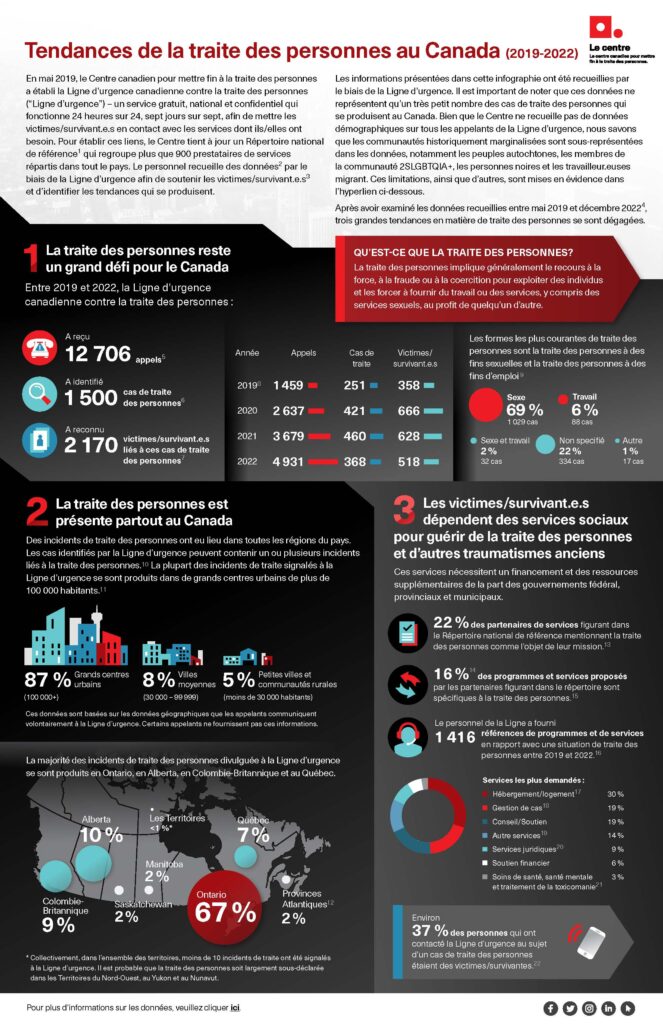
Les tendances de la traite des personnes au Canada (2019-2022)
Selon de nouvelles données, la traite des personnes demeure un défi important au Canada.
Toronto (Canada), le 27 juillet 2023 – La Ligne d’urgence canadienne contre la traite des personnes a identifié 1 500 cas de traite de personnes depuis son lancement en mai 2019. Les données récemment publiées montrent que le nombre de cas a fluctué entre 251 et 460 cas par an. Pendant cette période, la Ligne d’urgence a soutenu 2 170 victimes et survivant.e.s de la traite des personnes. Les victimes/survivant.e.s constituaient le principal groupe d’appelants – environ 37 % – s’adressant au service confidentiel et centré sur la personne de la Ligne d’urgence.
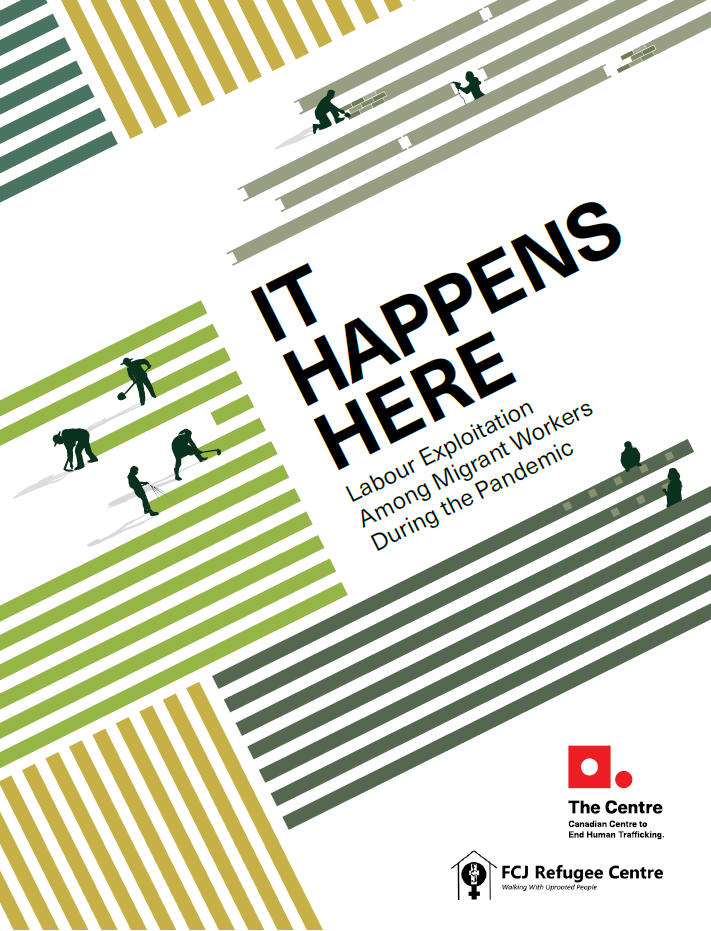
It Happens Here: Labour Exploitation Among Migrant Workers During the Pandemic
Concerns about labour trafficking increase amid higher demand for migrant workers in Canada.
Toronto, Canada, February 15, 2023 – New research shows that employer discrimination, unsafe working conditions and gaps in government policy put migrant workers at risk of being exploited once they arrive in Canada.
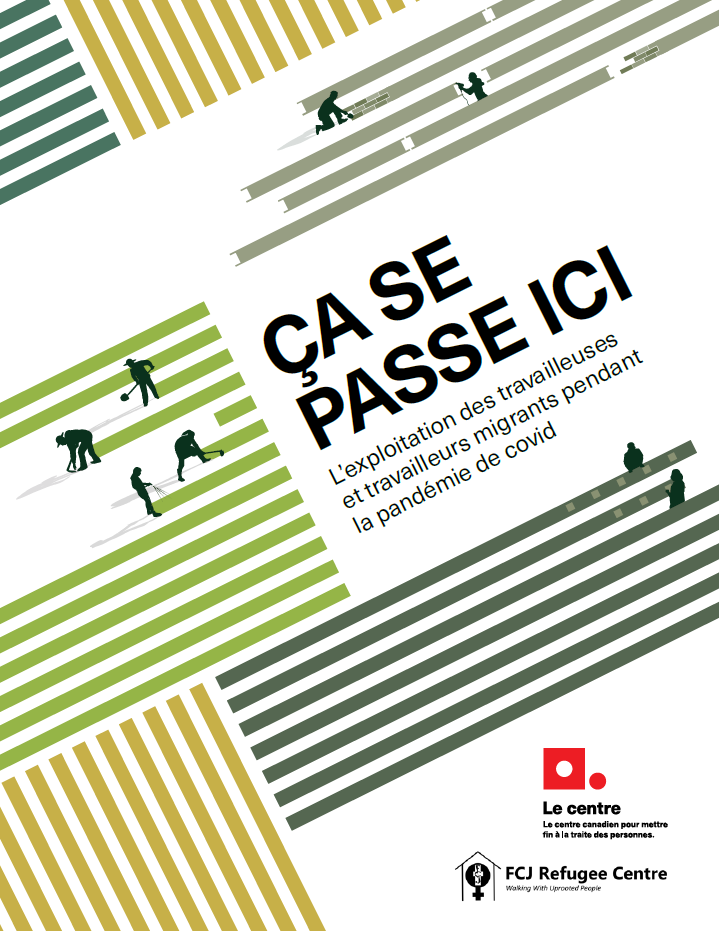
Hausse des craintes d’exploitation de la main-d’œuvre dans un contexte de demande accrue de travailleurs migrants au Canada
Toronto (Canada), le 15 février 2023. – Une nouvelle étude pointe du doigt la discrimination des employeurs, les conditions de travail dangereuses et les lacunes des politiques publiques dans l’augmentation des risques d’exploitation des travailleurs et travailleuses migrants qui arrivent au Canada.
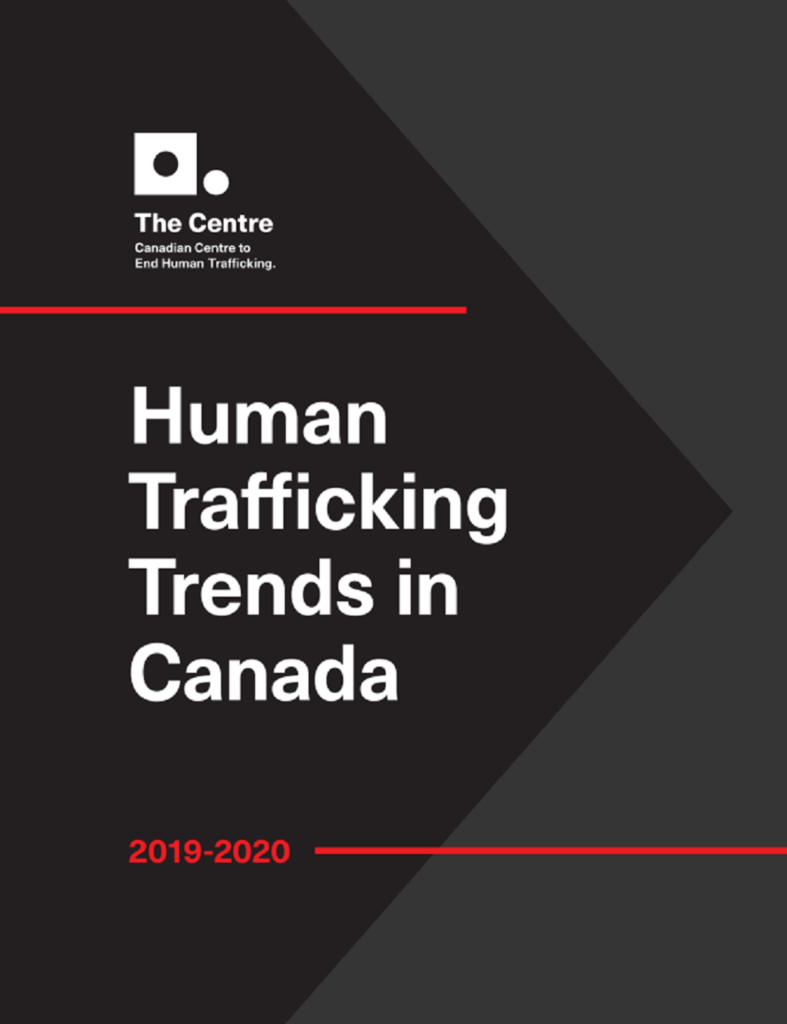
Human Trafficking Trends in Canada (2019-2020)
In Canada, 90 per cent of sex trafficking survivors are women and girls.
Toronto, Canada, October 14, 2021 – Data gathered during the Canadian Human Trafficking Hotline’s first year of operations shows that sex trafficking is a gender-based crime that predominantly impacts Canadian women and girls. The Centre’s report is a first of its kind in Canada in that it does not rely on police-reported statistics. Instead, The Centre has used non-attributable data collected from the Canadian Human Trafficking Hotline to identify six broad trafficking trends in Canada.
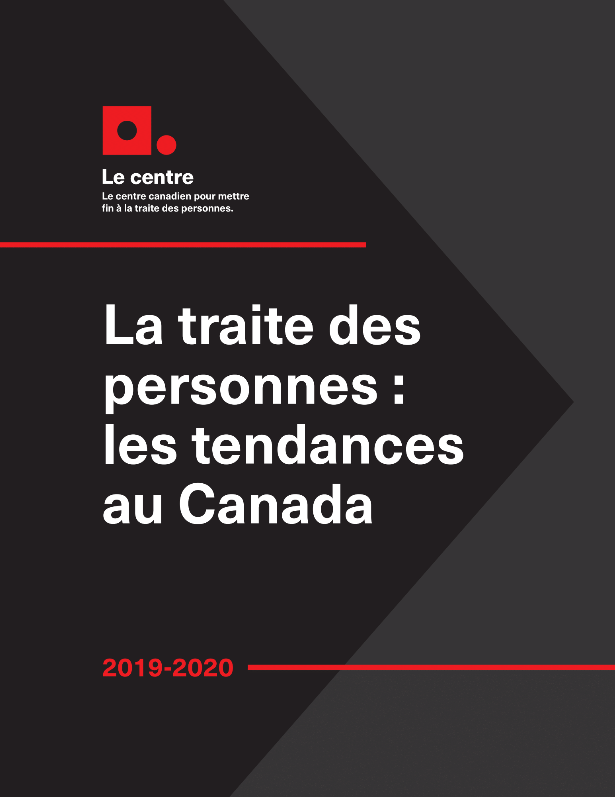
La traite des personnes : les tendances au Canada (2019-2020)
Au Canada, 90 pour cent des survivants de la traite des personnes à des fins d’exploitation sexuelle sont des femmes et des filles
Toronto (Canada), le 14 octobre 2021 – Les données recueillies au cours de la première année d’exploitation de la Ligne d’urgence canadienne contre la traite des personnes indiquent que la traite des personnes à des fins d’exploitation sexuelle est un crime fondé sur le genre qui touche d’abord et avant les femmes et les filles canadiennes. Pour la première fois au Canada, le rapport du Centre est une publication qui ne se fonde pas sur les statistiques fournies par les corps policiers. Le Centre a plutôt utilisé les données anonymes recueillies par la Ligne d’urgence canadienne contre la traite des personnes pour cerner six grandes tendances en matière de traite des personnes au Canada.
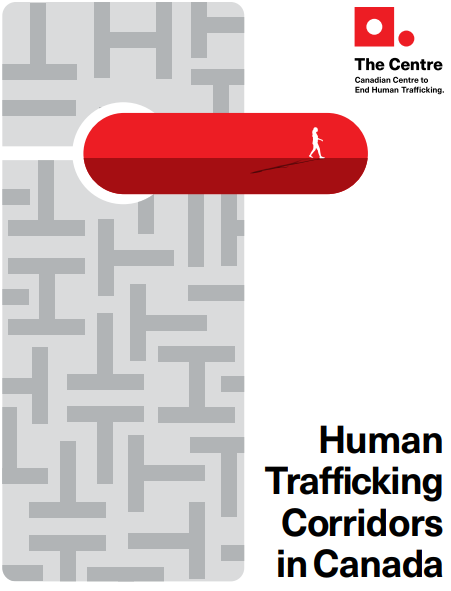
Human Trafficking Corridors in Canada
Human Trafficking Corridors Enable Traffickers to Exploit More Canadian Women and Girls
Toronto, Canada, 22 February 2021 – Human traffickers are reaping large profits across Canada using defined transportation corridors in Canada to exploit and control their victims, according to a new report released by The Canadian Centre to End Human Trafficking.
Human Trafficking Corridors in Canada, is a first-ever study of human trafficking transportation corridors in the country, notes that human traffickers benefit from primary transportation routes across the country to maximize profit within commercial sex markets and to avoid being caught by law enforcement and potentially imprisoned.
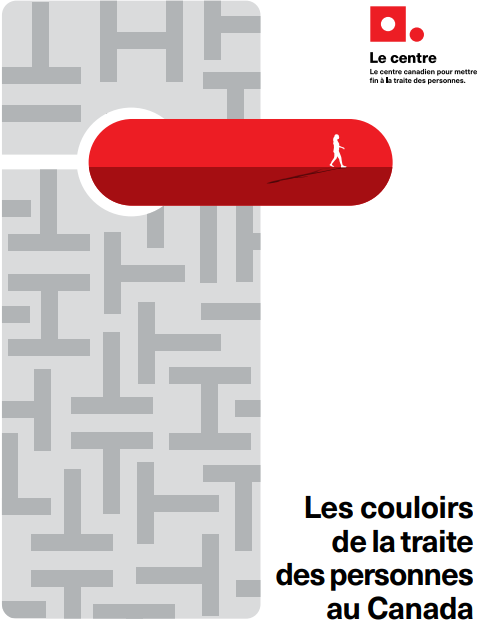
Les couloirs de la traite de personnes au Canada
Au Canada, Les Couloirs de la Traite des Personnes Permettent aux Trafiquants d’Exploiter Davantage de Filles et de Femmes Canadiennes
Toronto, Canada, 22 février 2021 – Des trafiquants récoltent d’importants profits partout au pays en utilisant des corridors de transport bien définis au Canada afin d’exploiter et de contrôler leurs victimes; voilà ce que révèle un nouveau rapport diffusé par le Centre Canadien Pour Mettre Fin à la Traite Des Personnes.
Les couloirs de la traite de personnes au Canada est la toute première étude sur les couloirs de transport et de traite de personnes au Canada, qui nous révèle que les trafiquants bénéficient grandement des routes de transport primaires à l’échelle du pays afin de maximiser leurs profits au sein de marchés du commerce sexuel ainsi que pour éviter de se faire prendre par les autorités policières et possiblement emprisonnés.
This report provides an overview of human trafficking in Canada. It includes the state of our knowledge on this complex and multi-faceted issue, the Canadian response to combat this atrocious crime, and the challenges faced by victims, services providers, law enforcement agencies and prosecutors to prevent human trafficking, protect its victims and prosecute the traffickers. The Committee drew upon the evidence it received to formulate key findings and recommendations aimed at strengthening Canada’s actions towards eradicating human trafficking in Canada.
This Discussion Paper was prepared by Public Safety Canada in consultation with the federal Human Trafficking Taskforce. Its purpose is to elicit discussion and comments to inform the Government of Canada in the development of a new national strategy to end human trafficking. It aims to help ensure that the new national strategy is evidence-based, and supports the prevention of this crime and the protection of its victims. The structure and contents of this document – particularly the potential areas of focus – are meant to guide the discourse rather than to reflect the final elements of a national strategy, which will take into account comments received on both this paper and feedback received through other engagement activities. The Discussion Paper includes a particular focus on the results of the evaluation of the 2012-2016 National Action Plan to Combat Human Trafficking and lessons learned by the Government of Canada throughout the Action Plan’s implementation, including commentary from several national roundtables. A number of key issues and questions are presented for consideration, with a view to facilitate contributions of stakeholders involved in the consultations.
Preventing human trafficking: Global issue, calling Canada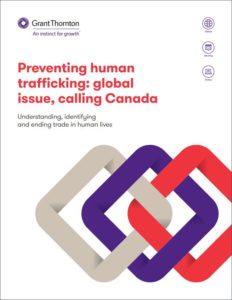 This report published by Grant Thornton highlights the role the financial sector can play in helping victims of human trafficking and support the role of law enforcement by knowing how to detect suspicious financial activities that are often associated with this nefarious enterprise.
This report published by Grant Thornton highlights the role the financial sector can play in helping victims of human trafficking and support the role of law enforcement by knowing how to detect suspicious financial activities that are often associated with this nefarious enterprise.
New Brunswick Information Guide on Human Trafficking (English Version) (French Version)
This guide provides information on how to recognize, support, protect and assist a person who may be trafficked in the province of New Brunswick, Canada.
Income Challenges for Body Rub Attendants Report
This report published by CEASE explores the income realities for some women in Edmonton body rub parlours. This report was limited to English speaking subjects only, and does not represent the experiences of all working in Edmonton Body Rub parlous.
Safety and Violence in Body Rub Parlours Survey
A self report survey provides insight into forms of abuse and harassment experienced by 42 women work in body rub parlours in the City of Edmonton and recommendations for increasing work place safety.
The Truth and Reconciliation Final Report 2015
The final report of the Truth and Reconciliation Commission of Canada
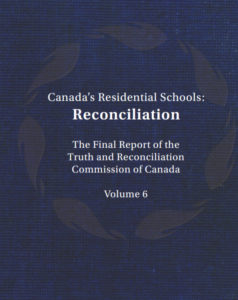
“To some people, “reconciliation” is the re-establishment of a conciliatory state. However, this is a state that many Aboriginal people assert has never existed between Aboriginal and non-Aboriginal people. To others, “reconciliation,” in the context of Indian residential schools, is similar to dealing with a situation of family violence. It is about coming to terms with events of the past in a manner that overcomes conflict and establishes a respectful and healthy relationship among people going forward. It is in the latter context that the Truth and Reconciliation Commission of Canada (trc) has approached the question of reconciliation.”
“NO MORE” Ending Sex Trafficking in Canada
Final Report of the National Task Force on Sex Trafficking of Women and Girls in Canada Fall 2014
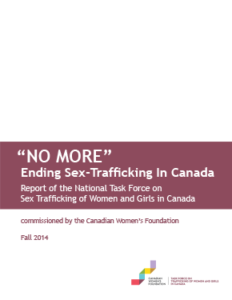
This ground-breaking, final report of the Task Force’s 24 Experts is the culmination of over 18 months of in-depth, cross-Canada consultations with representatives of over 260 organizations providing services to Survivors, 20 Canadian and international experts and, most importantly, the voices of over 160 Survivors of sex trafficking and/or sexual exploitation. The report focuses its findings and related 34 recommendations in the areas of changing systems, prevention and training programs, supports for women and girls, building public education and awareness and building avenues for collective action including possible philanthropic strategies.
We need to find our voices and say “NO MORE”
Report from the National Experiential Women’s Round Table December 5th and 6th, 2013
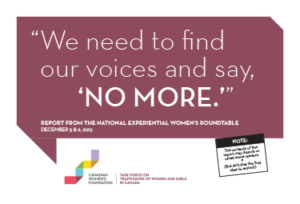 This provocative report summarizes the actual testimony of 20 survivors provided at the National Experiential Women’s Round table, hosted on December 5th and 6th, 2013 by the Task Force on Trafficking of Women and Girls in Canada. The report provides the round table findings expressed in the direct quotes of the 20 experiential women who participated and details their experiences through a framework that walks the reader through stages in their journey from girlhood through to the stage of exiting. This crucial report provides the reader with the authentic voices of Survivors and has not only documented factual evidence in their words of their horrifying experiences but also their recommendations for change that could bring an end to the abhorrent crime of Sex Trafficking in Canada.
This provocative report summarizes the actual testimony of 20 survivors provided at the National Experiential Women’s Round table, hosted on December 5th and 6th, 2013 by the Task Force on Trafficking of Women and Girls in Canada. The report provides the round table findings expressed in the direct quotes of the 20 experiential women who participated and details their experiences through a framework that walks the reader through stages in their journey from girlhood through to the stage of exiting. This crucial report provides the reader with the authentic voices of Survivors and has not only documented factual evidence in their words of their horrifying experiences but also their recommendations for change that could bring an end to the abhorrent crime of Sex Trafficking in Canada.
We are at a critical moment
Report from the National Round Table on Service Delivery for Trafficked Women and Girls in Canada September 18th, 2013
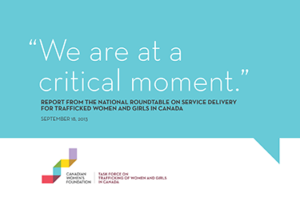 A round table was held at a central moment in the work of the Trafficking of Women and Girls in Canada Task Force while Task Force members were preparing to develop recommendations to assist to end the crime of sex trafficking in Canada. During this full-day round table, representatives from women’s, Indigenous and immigrant-serving organizations, police departments, shelters, hospitals, community organizations and anti-trafficking initiatives generated hundreds of ideas, practices and recommendations. This report details the results of this gathering that provided a unique opportunity for police and nurses, shelter workers and women’s advocates to meet as colleagues and identify services and system changes that could prevent trafficking in persons, identify and provide for the immediate needs of trafficked women and girls and suggest efforts that could assist women and girls to leave exploitative situations and rebuild their lives.
A round table was held at a central moment in the work of the Trafficking of Women and Girls in Canada Task Force while Task Force members were preparing to develop recommendations to assist to end the crime of sex trafficking in Canada. During this full-day round table, representatives from women’s, Indigenous and immigrant-serving organizations, police departments, shelters, hospitals, community organizations and anti-trafficking initiatives generated hundreds of ideas, practices and recommendations. This report details the results of this gathering that provided a unique opportunity for police and nurses, shelter workers and women’s advocates to meet as colleagues and identify services and system changes that could prevent trafficking in persons, identify and provide for the immediate needs of trafficked women and girls and suggest efforts that could assist women and girls to leave exploitative situations and rebuild their lives.
LAWS TO COMBAT SEX TRAFFICKING: An Overview of International, National, Provincial and Municipal Laws and their Enforcement
Nicole A. Barrett, Director, Global Justice Associates and Margaret J. Shaw, Director, Crime and Social Policy Consulting December 2013
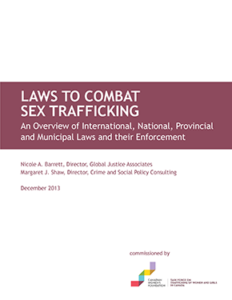 This report examines current legislation, regulations and law enforcement issues relating to human trafficking for sexual exploitation on the international, national, state/provincial, and municipal levels. An anal ysis of Canada’s legal framework for addressing sex trafficking is provided as well as details of its international obligations. The report also provides selected examples of foreign, national, provincial and state legislation on human trafficking and prostitution as well as a discussion on the regulation of the internet. Summary charts on current international, national, provincial and municipal responses, as well as an overall matrix of legislative responses to trafficking for sexual exploitation are included as appendices to the report.
This report examines current legislation, regulations and law enforcement issues relating to human trafficking for sexual exploitation on the international, national, state/provincial, and municipal levels. An anal ysis of Canada’s legal framework for addressing sex trafficking is provided as well as details of its international obligations. The report also provides selected examples of foreign, national, provincial and state legislation on human trafficking and prostitution as well as a discussion on the regulation of the internet. Summary charts on current international, national, provincial and municipal responses, as well as an overall matrix of legislative responses to trafficking for sexual exploitation are included as appendices to the report.
An Assessment of Sex Trafficking
Nicole Barrett, Director of Global Justice Associates May 2013
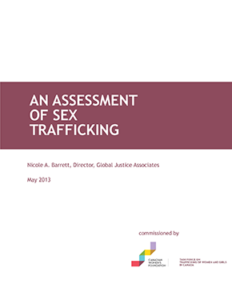 This report gathers and identifies important information on the prevalence of human trafficking in Canada in 2013, examines the profile of victims and the techniques of traffickers, and explores related area s in the human trafficking discussion – such as the demand to purchase sex in Canada, the role of the internet in sex trafficking, and the social and economic costs of sex trafficking. The report discusses impediments to accurately estimate the incidence of human trafficking, provides an overview of information known about the incidence of human trafficking in Canada, a profile of Canada’s sex trafficking victims and information on how sex trafficking is occurring in Canada. In addition, the report looks at existing information on the demand for sex trafficking from two perspectives: the sex buyer and the trafficker and asks how the internet is, and/or can be used, in trafficking situations.
This report gathers and identifies important information on the prevalence of human trafficking in Canada in 2013, examines the profile of victims and the techniques of traffickers, and explores related area s in the human trafficking discussion – such as the demand to purchase sex in Canada, the role of the internet in sex trafficking, and the social and economic costs of sex trafficking. The report discusses impediments to accurately estimate the incidence of human trafficking, provides an overview of information known about the incidence of human trafficking in Canada, a profile of Canada’s sex trafficking victims and information on how sex trafficking is occurring in Canada. In addition, the report looks at existing information on the demand for sex trafficking from two perspectives: the sex buyer and the trafficker and asks how the internet is, and/or can be used, in trafficking situations.
SEXUAL EXPLOITATION AND TRAFFICKING OF ABORIGINAL WOMEN AND GIRLS Literature Review and Key Informant Interviews
Native Women’s Association of Canada March 2014
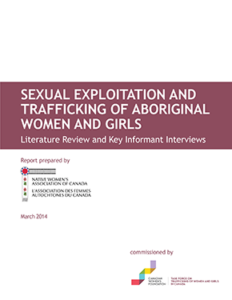
The Native Women’s Association of Canada (NWAC) is a national Indigenous organization representing the political voice of Aboriginal women throughout Canada. NWAC works to advance the well-being of Indigenous women and girls, as well as their families and communities through advocacy, policy, and legislative analysis to improve outcomes for Indigenous women and girls. This research seeks to form a comprehensive picture on the state of human trafficking for sexual exploitation of Indigenous women and girls in Canada. The review assisted to inform the work of NWAC and the Task Force on Trafficking of Women and Girls in Canada and aided in the Task Force’s preparations to identify and suggest key solutions for a national anti- trafficking strategy effectively addressing sexual exploitation of Indigenous women and girls in Canada.

